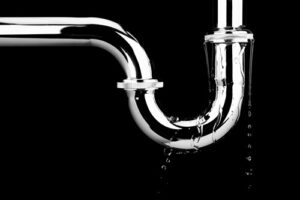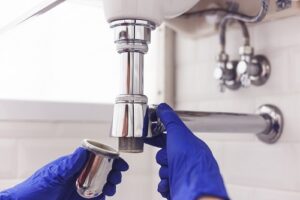Water, the essence of life, flows seamlessly through the intricate network of pipes that course beneath our homes and cities. However, this seemingly flawless system is not impervious to the passage of time and environmental influences.
Leaky pipes, a homeowner’s nightmare and a city planner’s concern, can lead to water wastage, property damage, and a cascade of issues that extend beyond the visible drip. In this article, we embark on a journey to uncover the silent assailants responsible for compromising the integrity of our plumbing systems.
Understanding the leading causes of leaky pipes is pivotal for homeowners, property managers, and municipalities alike.
From the gradual erosion caused by corrosive elements to the disruptive force of tree roots seeking nourishment, each factor contributes to the vulnerability of pipes in its own way. Join us as we delve into the depths of corrosion, age-related deterioration, and the myriad of influences that render our plumbing systems susceptible to leaks.
Through this exploration, we aim to shed light on the importance of proactive maintenance, proper installation practices, and the implementation of preventive measures to safeguard our essential water infrastructure.
Degrading Pipe Materials that Lead to Leaky Pipes
Material degradation is a significant factor contributing to the occurrence of leaky pipes, as various materials used in plumbing systems may undergo structural changes over time due to environmental conditions, water quality, and other external influences.
Degrading materials in which water pipes are made from can happen at different rates depending on a multitude of factors. However, the leading cause of material degradation in water pipes is the result of old age and regular use.
Here’s an elaboration on how material degradation can lead to leaks:
Corrosion:
Metal Pipes: Many plumbing systems, especially older ones, use metal pipes such as galvanized steel or copper. These materials are prone to corrosion, a natural process where they react with water or contaminants in the soil. Corrosion weakens the structural integrity of the pipes, leading to the formation of rust and eventually causing leaks.
Chemical Reaction:
Acidic Water: Water with a high acidity level can instigate chemical reactions with certain pipe materials. This can result in the breakdown of the material and the formation of weak spots or pinhole leaks. Additionally, exposure to harsh chemicals in the water, often due to industrial discharges or contamination, can accelerate the degradation process.
Polymer Aging:
Polybutylene Pipes: Although once popular for their cost-effectiveness, polybutylene pipes have been known to degrade over time. Exposure to chlorine in the water supply can cause these pipes to become brittle and prone to fractures, leading to leaks. Many jurisdictions have phased out the use of polybutylene pipes due to these issues.
Temperature Fluctuations:
Plastic Pipes: While plastic pipes are generally more resistant to corrosion, they can still be affected by temperature fluctuations. Extreme heat or cold can cause plastic pipes to expand and contract, potentially leading to material fatigue, microcracks, and eventual leaks.
Water Quality:
Hard Water: Water with high mineral content, known as hard water, can contribute to the degradation of pipes. The minerals in the water may deposit on the interior of the pipes, leading to a phenomenon called scaling. Over time, this buildup can reduce the flow capacity of the pipes and create conditions conducive to corrosion and leaks.
UV Exposure:
Exterior Pipes: Pipes exposed to sunlight can undergo degradation due to ultraviolet (UV) radiation. This is more relevant for exterior plumbing systems. UV exposure can weaken the material, making it more susceptible to cracks and leaks over time.
Addressing material degradation involves choosing appropriate pipe materials based on the specific conditions of the water supply and environment. Regular inspections, water quality monitoring, and preventive maintenance can help mitigate the impact of material degradation, extending the lifespan of plumbing systems and reducing the likelihood of leaks.
How does Poor Water Quality Lead to Leaky Pipes?
Poor water quality can contribute to the degradation of pipes and ultimately lead to leaks. Several factors associated with poor water quality can negatively impact the integrity of plumbing systems:
Corrosion:
Chemical Reactions: Water with a high acidity level or high mineral content can initiate chemical reactions with metal pipes. These reactions accelerate corrosion, causing the metal to deteriorate over time. Corroded pipes develop weak spots, rust, and eventually leaks.
Scaling:
Mineral Deposits: Hard water, which contains elevated levels of minerals such as calcium and magnesium, can lead to scaling inside pipes. As these minerals accumulate, they create deposits that restrict water flow and contribute to corrosion. The presence of scale promotes the formation of pits and rough surfaces on the pipe interior, making it more prone to leaks.
Sediment Buildup:
Particulate Matter: Water with high levels of sediment or suspended particles can lead to the buildup of debris inside pipes. This accumulation can create abrasive conditions, increasing the likelihood of physical wear and tear on the pipe walls. Over time, this wear weakens the material, making it more susceptible to leaks.
Microbial Growth:
Biofilm Formation: Poor water quality may contain organic matter that supports the growth of microorganisms. Biofilms, comprised of bacteria and other microorganisms, can form on the inner surfaces of pipes. These biofilms create a protective layer that can contribute to corrosion and degrade the pipe material, potentially leading to leaks.
Chlorine Exposure:
Plastic Pipe Degradation: Chlorine is commonly added to municipal water supplies for disinfection. While it serves a crucial role in ensuring water safety, prolonged exposure to high levels of chlorine can degrade plastic pipes. For example, polybutylene pipes are known to become brittle and prone to failure when exposed to high chlorine levels, resulting in leaks.
Temperature Variations:
Thermal Stress: Poor water quality, combined with temperature fluctuations, can subject pipes to thermal stress. Rapid changes in temperature can cause pipes to expand and contract, leading to fatigue and potential cracking. These cracks create openings for water to escape, resulting in leaks.
Addressing poor water quality and its impact on plumbing systems involves implementing water treatment measures, such as installing water softeners to mitigate hardness or using corrosion inhibitors to protect metal pipes. Regular water quality testing and maintenance are essential to identify potential issues early on and prevent the deterioration of pipes, reducing the risk of leaks and ensuring the longevity of the plumbing infrastructure.
How Often do Tree Roots Lead to Leaky Pipes for Homeowners?
Tree roots can be a common cause of leaky pipes, particularly in older sewer systems or if there are trees planted in close proximity to underground plumbing. The frequency with which tree roots cause leaky pipes depends on various factors, including the type of pipes, the species of trees, soil conditions, and the presence of moisture. Here are some considerations:
Type of Pipes:
Older pipes, especially those made of materials like clay or concrete, are more susceptible to root intrusion. Modern pipes made of materials like PVC or HDPE are more resistant to root penetration.
Tree Species:
Different tree species have varying root structures and growth patterns. Trees with aggressive and expansive root systems, such as certain types of hardwoods, are more likely to seek out water sources, including underground pipes.
Proximity to Pipes:
Trees planted in close proximity to underground pipes increase the likelihood of root intrusion. The closer the tree is to the pipes, the more likely it is that roots will come into contact with the plumbing system.
Soil Conditions:
The type and moisture content of the soil can influence root behavior. Loose or sandy soils may allow roots to penetrate more easily than dense or compacted soils.
Moisture Levels:
Tree roots are attracted to moisture, and they can actively seek out water sources. If there are leaks or condensation around pipes, it can attract roots to the area, increasing the chances of intrusion.
Age of Trees and Pipes:
As both trees and pipes age, the likelihood of root intrusion tends to increase. Mature trees have larger and more developed root systems, while older pipes may have developed cracks or joints that allow roots to enter.
While it is challenging to provide a specific frequency, it’s not uncommon for tree roots to cause issues with underground pipes, especially in regions with a high prevalence of trees and older sewer systems. Regular inspections, proactive maintenance, and the use of root barriers or chemical treatments can help mitigate the risk of tree root intrusion and minimize the occurrence of leaky pipes. Homeowners and property managers should be vigilant in monitoring their plumbing systems and address any signs of root-related problems promptly to prevent extensive damage.
As we conclude our exploration into the labyrinthine world of plumbing systems, it becomes abundantly clear that understanding and addressing the leading causes of leaky pipes is not merely a matter of practicality but a fundamental aspect of responsible homeownership. The invisible adversaries that threaten the integrity of our pipes, from the gradual corrosion induced by time to the persistent advances of tree roots seeking nourishment, underscore the importance of vigilance and proactive maintenance.
For homeowners, the repercussions of leaky pipes extend beyond the inconvenience of a dripping faucet or a damp ceiling. Water damage can wreak havoc on the structural integrity of a home, leading to costly repairs, compromised indoor air quality, and potential health hazards. It is incumbent upon us, as stewards of our homes, to adopt a preventative mindset and take decisive measures to shield our plumbing systems from these insidious threats.
Investing time and resources in routine inspections emerges as a critical strategy in identifying early warning signs of corrosion, age-related deterioration, or the encroachment of tree roots. By catching these issues in their nascent stages, homeowners can implement timely repairs, forestalling the progression of damage and averting the cascade of problems associated with leaky pipes.
Furthermore, the choice of suitable materials during installation plays a pivotal role in determining the longevity of plumbing systems. Modern materials resistant to corrosion and wear, coupled with proper installation practices, provide a robust defense against the relentless march of time and environmental influences.
In the realm of water quality, homeowners must be cognizant of the composition of their water supply. From acidic water that accelerates corrosion to hard water that fosters scaling, understanding the quality of the water coursing through our pipes allows for tailored interventions, such as water softeners or corrosion inhibitors, to mitigate potential damage.
As we bid adieu to the enigmatic world beneath our homes, the narrative echoes the importance of an informed and proactive approach. By staying attuned to the silent whispers of our plumbing systems, we empower ourselves to protect our homes against the ever-present threat of leaky pipes. Let this journey serve as a call to action, urging homeowners to embrace the role of guardians of their domestic sanctuaries, equipped with the knowledge and tools necessary to fortify their homes against the subtle but significant challenges that lie beneath the surface.

